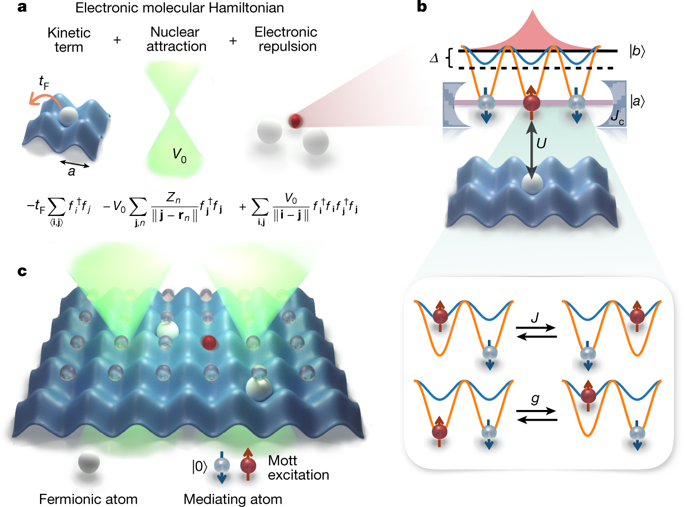Our official English website, www.x-mol.net, welcomes your
feedback! (Note: you will need to create a separate account there.)
Analogue quantum chemistry simulation
Nature ( IF 50.5 ) Pub Date : 2019-10-09 , DOI: 10.1038/s41586-019-1614-4 Javier Argüello-Luengo , Alejandro González-Tudela , Tao Shi , Peter Zoller , J. Ignacio Cirac
Nature ( IF 50.5 ) Pub Date : 2019-10-09 , DOI: 10.1038/s41586-019-1614-4 Javier Argüello-Luengo , Alejandro González-Tudela , Tao Shi , Peter Zoller , J. Ignacio Cirac

|
Computing the electronic structure of molecules with high precision is a central challenge in the field of quantum chemistry. Despite the success of approximate methods, tackling this problem exactly with conventional computers remains a formidable task. Several theoretical1,2 and experimental3–5 attempts have been made to use quantum computers to solve chemistry problems, with early proof-of-principle realizations done digitally. An appealing alternative to the digital approach is analogue quantum simulation, which does not require a scalable quantum computer and has already been successfully applied to solve condensed matter physics problems6–8. However, not all available or planned setups can be used for quantum chemistry problems, because it is not known how to engineer the required Coulomb interactions between them. Here we present an analogue approach to the simulation of quantum chemistry problems that relies on the careful combination of two technologies: ultracold atoms in optical lattices and cavity quantum electrodynamics. In the proposed simulator, fermionic atoms hopping in an optical potential play the role of electrons, additional optical potentials provide the nuclear attraction, and a single-spin excitation in a Mott insulator mediates the electronic Coulomb repulsion with the help of a cavity mode. We determine the operational conditions of the simulator and test it using a simple molecule. Our work opens up the possibility of efficiently computing the electronic structures of molecules with analogue quantum simulation. An analogue quantum simulator based on ultracold atoms in optical lattices and cavity quantum electrodynamics is proposed for the solution of quantum chemistry problems and tested numerically for a simple molecule.
中文翻译:

模拟量子化学模拟
高精度计算分子的电子结构是量子化学领域的核心挑战。尽管近似方法取得了成功,但使用传统计算机准确解决这个问题仍然是一项艰巨的任务。已经进行了一些理论 1,2 和实验 3-5 尝试,以使用量子计算机来解决化学问题,并以数字方式完成了早期的原理验证实现。数字方法的一个有吸引力的替代方案是模拟量子模拟,它不需要可扩展的量子计算机,并且已经成功应用于解决凝聚态物理问题 6-8。然而,并非所有可用或计划的设置都可用于量子化学问题,因为不知道如何设计它们之间所需的库仑相互作用。在这里,我们提出了一种模拟量子化学问题的模拟方法,该方法依赖于两种技术的仔细组合:光学晶格中的超冷原子和腔量子电动力学。在提议的模拟器中,在光势中跳跃的费米原子扮演电子的角色,额外的光势提供核吸引力,莫特绝缘体中的单自旋激发在腔模式的帮助下介导电子库仑排斥。我们确定模拟器的操作条件并使用一个简单的分子对其进行测试。我们的工作开辟了使用模拟量子模拟有效计算分子电子结构的可能性。
更新日期:2019-10-09
中文翻译:

模拟量子化学模拟
高精度计算分子的电子结构是量子化学领域的核心挑战。尽管近似方法取得了成功,但使用传统计算机准确解决这个问题仍然是一项艰巨的任务。已经进行了一些理论 1,2 和实验 3-5 尝试,以使用量子计算机来解决化学问题,并以数字方式完成了早期的原理验证实现。数字方法的一个有吸引力的替代方案是模拟量子模拟,它不需要可扩展的量子计算机,并且已经成功应用于解决凝聚态物理问题 6-8。然而,并非所有可用或计划的设置都可用于量子化学问题,因为不知道如何设计它们之间所需的库仑相互作用。在这里,我们提出了一种模拟量子化学问题的模拟方法,该方法依赖于两种技术的仔细组合:光学晶格中的超冷原子和腔量子电动力学。在提议的模拟器中,在光势中跳跃的费米原子扮演电子的角色,额外的光势提供核吸引力,莫特绝缘体中的单自旋激发在腔模式的帮助下介导电子库仑排斥。我们确定模拟器的操作条件并使用一个简单的分子对其进行测试。我们的工作开辟了使用模拟量子模拟有效计算分子电子结构的可能性。


















































 京公网安备 11010802027423号
京公网安备 11010802027423号